Automate Aseptic Filling: Closing the System at Full Modularity
Shifting to automated, closed modular manufacturing systems is growing increasingly crucial for biopharmaceutical production.
xmagics - stock.adobe.com
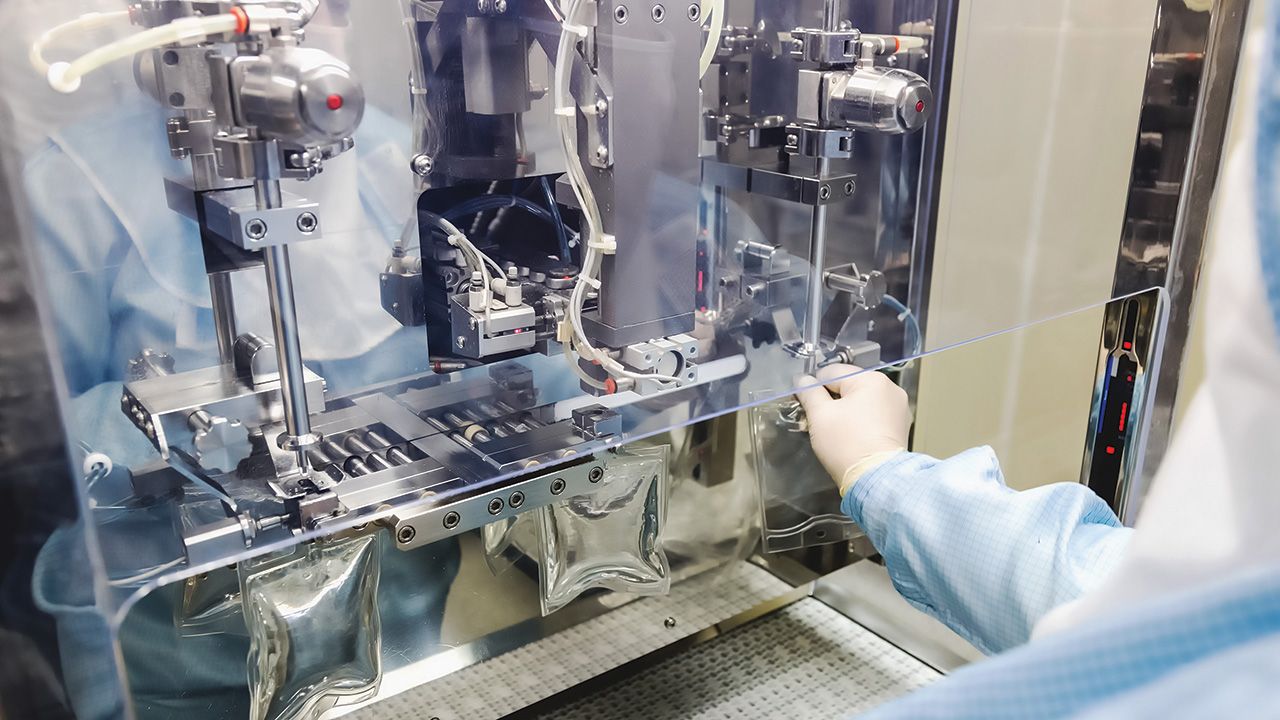
In the course of the significant transformation of the biopharmaceutical industry, modular manufacturing emerges as a game-changing approach to fluid management. This innovative methodology is reshaping how pharmaceutical companies and contract development and manufacturing organizations (CDMOs) produce and handle biopharmaceuticals, offering unprecedented flexibility, efficiency, and scalability.
Modular manufacturing in biopharmaceutical fluid management (Figure 1) is crucial for the following reasons:
- It allows for rapid adaptation that is due to either changing market demands or product specifications.
- It enables manufacturers to optimize their production processes, reducing costs and improving product quality.
- It facilitates easier compliance with regulatory requirements.
ALL FIGURES ARE COURTESY OF THE AUTHOR. Figure 1. An automated aseptic filling platform.
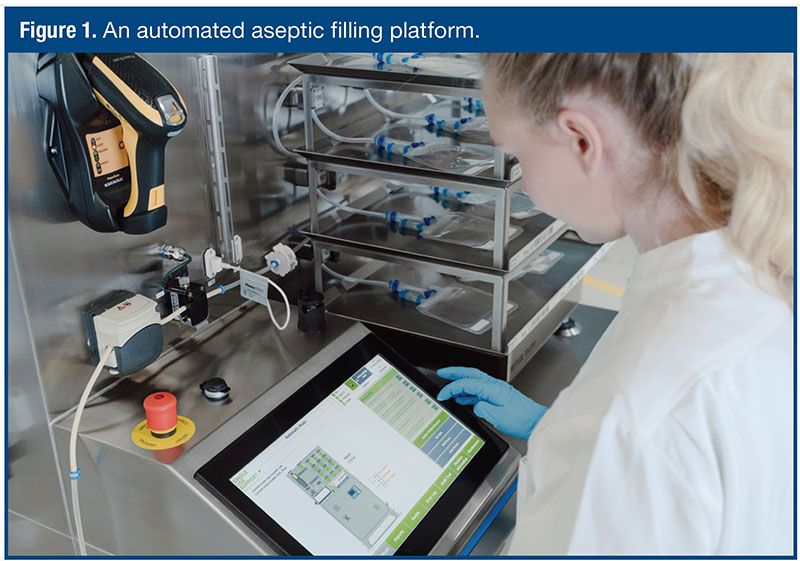
The latter is true when technologies provide better control and traceability throughout the manufacturing process. The integration of modular systems with manufacturing execution systems (MES) helps ensure seamless operations, real-time monitoring, and data-driven decision-making.
Overall, the approach to add modularity is particularly valuable when dealing with diverse product portfolios, varying batch sizes, and the potential need for quick scale-up or scale-out capabilities.
Process flexibility: a necessity in modern biomanufacturing
In today’s dynamic biopharmaceutical landscape, process flexibility is not just an advantage—it’s a necessity. CDMOs, in particular, face the challenge of producing a wide array of products with different specifications, volumes, and handling requirements.
One of the primary drivers for process flexibility is the diverse nature of biopharmaceutical products. From monoclonal antibodies (mAbs) to cell and gene therapies, each product may require unique processing conditions, volumes, and handling protocols. Such a volatile demand necessitates rapid scalability.
Will the COVID-19 pandemic remain unique? Uncertain. However, it has prompted manufacturers to be more prepared for potential further outbreaks, such as monkeypox. With pandemic preparedness comes the importance of being able to scale up production swiftly. Modular manufacturing systems provide the agility needed to respond to such sudden surges in demand. They also allow CDMOs to quickly reconfigure their production lines to accommodate these varying needs without significant downtime or retooling or alternatively piling equipment for all possible events and scales.
Why would CDMOs invest in a full set of multiple technologies when they can have one modular system for many scenarios?
Fluid management in manufacturing: the shift to automated closed systems
Fluid management is all about transferring liquids in biopharmaceutical manufacturing between different process steps. This can be the case in upstream, downstream, fill/finish, or in between. The industry is witnessing a transition from manual, open handling to automated closed systems, in large part due to Annex 1 of the European Commission’s guidelines, which favors closed systems. This regulatory requirement has been effective in shifting the interest of manufacturers and CDMOs to automated closed systems (1). The shift in attitude is primarily driven by the need for increased sterility, reduced contamination risks, and improved process control. Even for aliquoting small volumes into single-use bags, closed systems are increasingly being used (see Figure 2).
Figure 2. Aliquotation of biopharmaceuticals into small single-use bags.
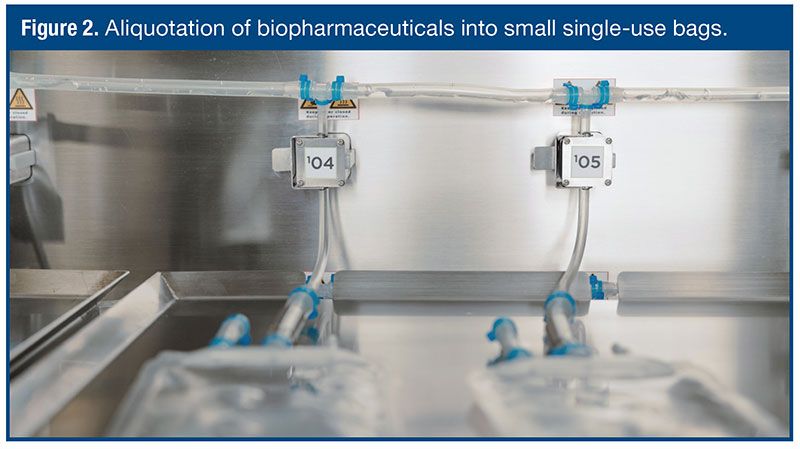
Why would a manufacturer or CDMO want to close the fluid path system? Responses to this question include the following:
- Enhanced sterility: by minimizing human intervention and exposure to the environment, closed systems significantly reduce the risk of contamination.
- Improved process control: automated systems allow for precise control over filling parameters, ensuring consistency across batches.
- Increased efficiency: automation reduces manual handling, leading to faster processing times and reduced labor costs.
- Better traceability: closed systems integrated with MES provide comprehensive data logging, facilitating easier compliance with regulatory requirements.
Six most current pain points and challenges in fluid management
Despite the advancements in fluid management processes, several challenges persist in the biopharmaceutical industry.
Only limited scalability. Many current systems struggle to accommodate varying production volumes efficiently. So many aspects can change, be it the batch volume or the size of the primary packaging. Does the manufacturer fill 100 L of antibody-drug conjugates into five single-use bags of 20 L? Or does the manufacturer dispense 20 L of viral vectors into 40 single-use bags of 500 mL? Do mAbs even need to be filled into 20 1-L bottles?Scaling up, down, or out often requires significant changes to equipment or processes, leading to increased costs and downtime.
Vendor-dependent ecosystems. There is one closed system that CDMOs do not like—the closed ecosystem of technologies. A vendor lock-in and the resulting incompatibilities can restrict flexibility and increase costs for manufacturers. If Solution Provider A only accepts its own single-use assemblies, single-use bags, and sometimes even platform systems and not those of Vendor B or C, it limits both the drive for optimization and productivity and simply prevents CDMOs from following suit with their customers’ mandatory equipment.
Footprint availability. The need for different systems to handle various scales of production leads to increased capital expenditure, larger footprints, and more complex training requirements for operators, even more when platform systems are not modular. Adding a number of technologies does not necessarily equal scalability. More equipment is just a problem with regards to footprint in manufacturing suites.
Filling accuracy for small volumes. As the industry moves toward advanced therapy medicinal products (ATMPs) and personalized medicines, the need for precise handling of small volumes becomes critical. Many existing systems lack the required accuracy for these applications into single-use bags. In most cases, scales are integrated to measure larger filling quantities, while flow sensors are used to aliquot smaller volumes.
Cooling liquids before aliquotation. Some biopharmaceuticals, particularly cell-based products, always require precise temperature control. Otherwise, inaccurate temperatures reduce cell viability, such as when cells are held too warm for too long. Most current systems struggle to maintain optimal temperatures in process steps before the cooling process.
Wasting residual volume. Most existing systems often leave significant residual volumes in tubing and containers, leading to product waste and reduced yield. This waste can be limited by draining single-use assemblies post filling with negative pressure.
Streamlining requirements: a (liquid) path forward
All of the mentioned pain points are issues that every manufacturer would want to be solved. But do all these pain points make sense for a specific manufacturer’s production? These points are of importance when biopharmaceutical manufacturers and CDMOs carefully consider their project criteria and priorities when selecting or designing fluid management systems.
What are the key project criteria, and in what order should these criteria be prioritized? Answering these questions helps a manufacturer find the most suitable filling platform and allows them to make trade-offs between some options. Examples are illustrated in Figure 3; if it is important to fill small volumes (e.g., ATMPs) as accurately as possible, then speed of filling might not be the biggest priority. If it is the speed that counts, then the speed may reduce the accuracy and the option to homogenize drugs before the filling process to ensure aliquot-to-aliquot consistent product quality throughout.
Figure 3. Examples of project priorities for aseptic filling.
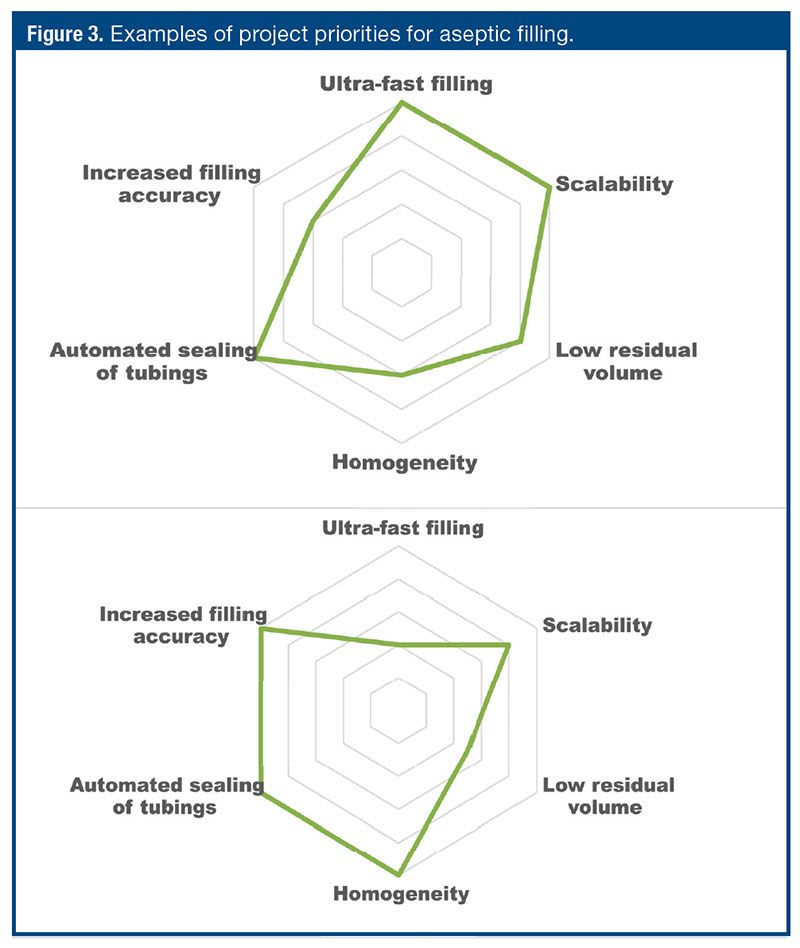
Advanced filling platform systems adapting to criteria. Modular, adaptable platform systems are more likely to meet manufacturers’ defined criteria and priorities. Most innovative automated aseptic filling platforms offer several key features, such as:
- Unified platform communication: implementing a standardized communication protocol across different scales enables seamless changes in production capacity without major system overhauls. Whatever MES is used, the platform systems require an interface to seamlessly be integrated into the current system, such as withOpen Platform Communication Unified Architecture (OPC UA).
- Plug-and-play architecture: a single control unit that can accommodate different racks or modules, allowing for easy reconfiguration based on production needs. Even multiple racks can be attached to the control unit for large-scale operations.
- Flexible pumping systems: incorporating pumps that can accurately handle a wide range of volumes, from microliters to liters. Large peristaltic pumps can be as accurate as +/-2 g filling accuracy, for example, but may not be fully suitable for certain drug substances. Depending on the product characteristics, different pump setups can be considered.
- Advanced sealing technologies: predominantly performed manually, there is also a possibility to implement an automated sealing mechanisms to maintain system closure and sterility. Certain pinch valves can automatically seal the tubing right after the filling process, as shown in Figure 4, which helps skip one process step of aseptically decoupling fully.
- Cooling liquids for aliquotation process: connecting cooling functions directly to the filling platform helps to maintain product integrity for temperature-sensitive biopharmaceuticals. For example, cell-based products are cooled prior to the filling process during homogenization and mixing to maximize cell viability (2).
- Optimized tubing design: enlarging the inner and outer diameters of tubing where appropriate to accommodate higher flow rates and reduce flow rates for low amounts of residual volumes. Integrated pinch valves need to be compatible to tubing of different sizes and characteristics. This allows a wider spectrum of scales and filling accuracy for manufacturers.
Figure 4. Sealing pinch valves for aseptic decoupling.
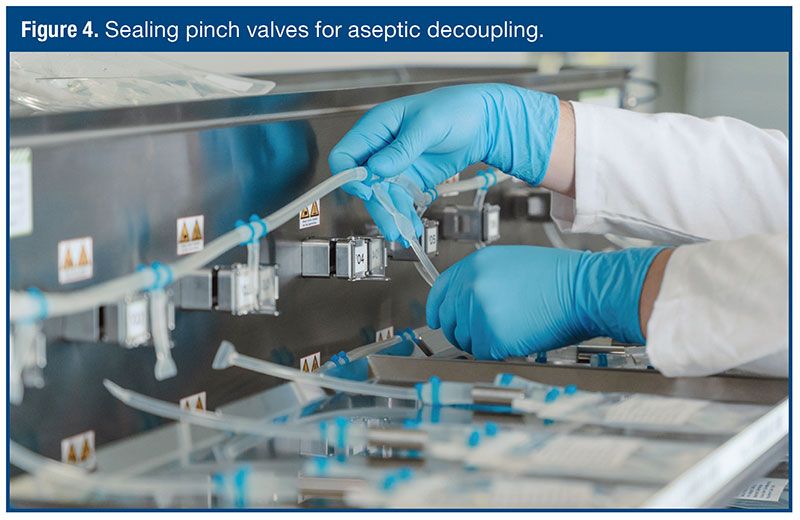
Why modular filling platforms can no longer be overlooked by CDMOs
Modular manufacturing in biopharmaceutical fluid management marks a significant advancement in the industry, offering a multitude of benefits that are essential for modern production demands. One of the most compelling advantages is increased flexibility, which allows manufacturers and CDMOs to swiftly adapt to varying product requirements and batch sizes. This adaptability is crucial in a landscape where market needs can change rapidly.
Moreover, these modular systems contribute to improved efficiency by reducing setup times and facilitating easier changeovers between products, ultimately leading to higher overall equipment effectiveness. The cost-effectiveness of modular platforms cannot be overstated; by consolidating multiple dedicated systems into a single, versatile platform, companies can significantly lower capital expenditures and optimize their manufacturing footprint.
Quality control is enhanced through the implementation of closed, automated systems that minimize human error and contamination risks, ensuring consistent product quality. Additionally, the integrated data management and traceability features simplify regulatory compliance, making it easier for manufacturers to meet stringent industry standards.
As the biopharmaceutical landscape evolves, the adaptability of modular systems provides a vital degree of future proofing, allowing facilities to upgrade or expand as new technologies and regulations emerge. Furthermore, the ability to quickly scale up production can substantially shorten the time required to bring new products to market, giving companies a competitive edge.
In fact, those who embrace modular manufacturing will be well positioned to navigate the complexities of the biopharmaceutical industry, respond to changing demands, and thrive in an increasingly competitive environment. The future of biopharmaceutical manufacturing lies in modularity.
References
1. European Commission. The Rules Governing Medicinal Products in the European Union Volume 4 EU Guidelines for Good Manufacturing Practice for Medicinal Products for Human and Veterinary Use. 8.127 of Annex 1 (2022).
2. Moloney, B. Homogenization of Cells & Aliquotation in Single-use Bags. susupport.com/knowledge, Aug. 9, 2023.
About the author
Jonathan Haider, j.haider@susupport.com, is product line manager at Single Use Support.
Article details
Pharmaceutical Technology®
Vol. 48, No. 11
November 2024
Pages: 17–19, 30
Citation
When referring to this article, please cite it as Haider, J. Automate Aseptic Filling: Closing the System at Full Modularity. Pharmaceutical Technology 2024, 48 (11), 17–19, 30.
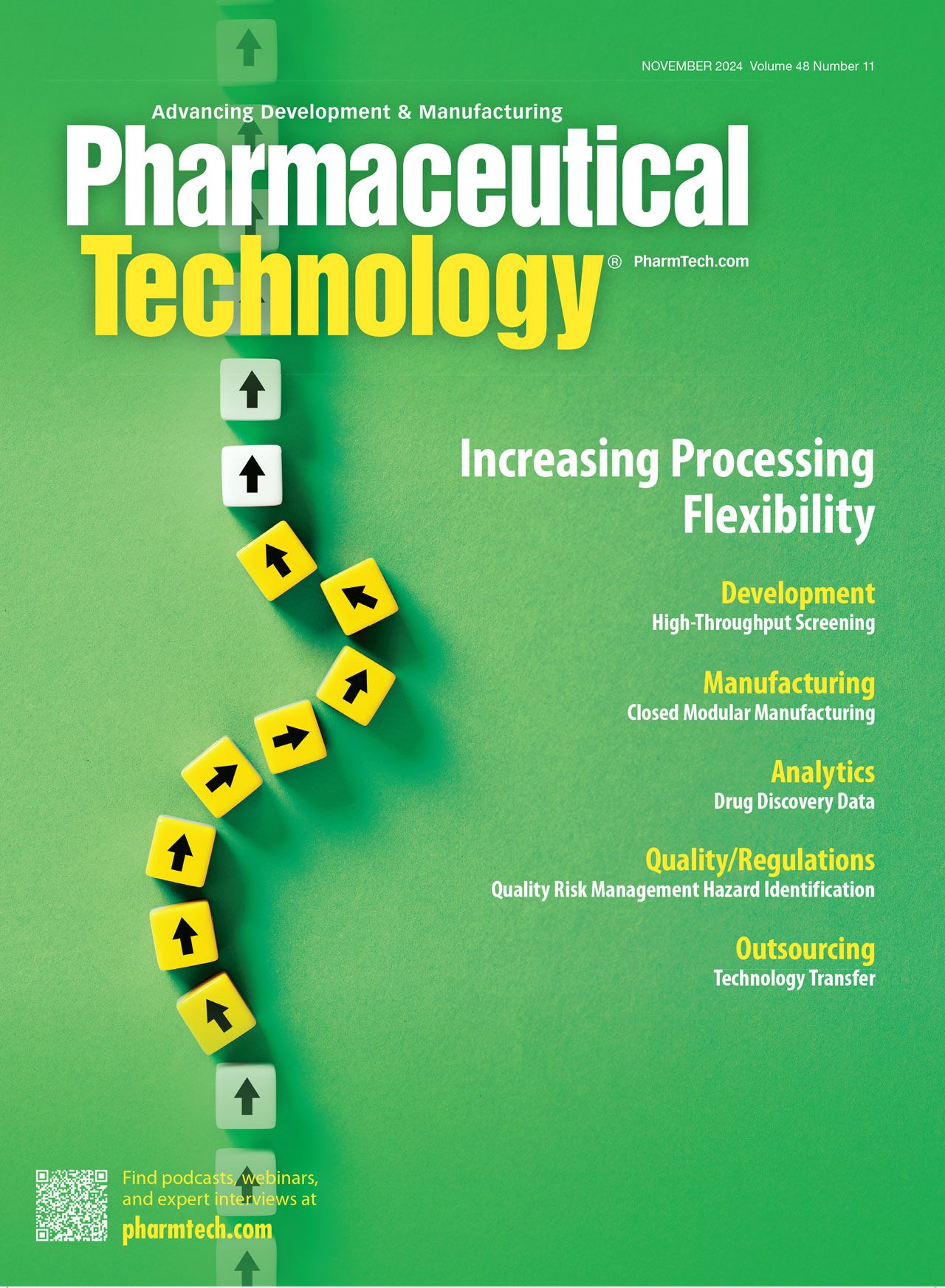
Drug Solutions Podcast: A Closer Look at mRNA in Oncology and Vaccines
April 30th 2024In this episode fo the Drug Solutions Podcast, etherna’s vice-president of Technology and Innovation, Stefaan De Koker, discusses the merits and challenges of using mRNA as the foundation for therapeutics in oncology as well as for vaccines.
Entering New Domains for 3D Printing of Drug Products
April 6th 20253D printing of personalized medications is currently possible under existing compounding regulations, offering enhanced process control through automation. But new legislation coming in 2025 will allow 3D printing as part of a distributed manufacturing framework.